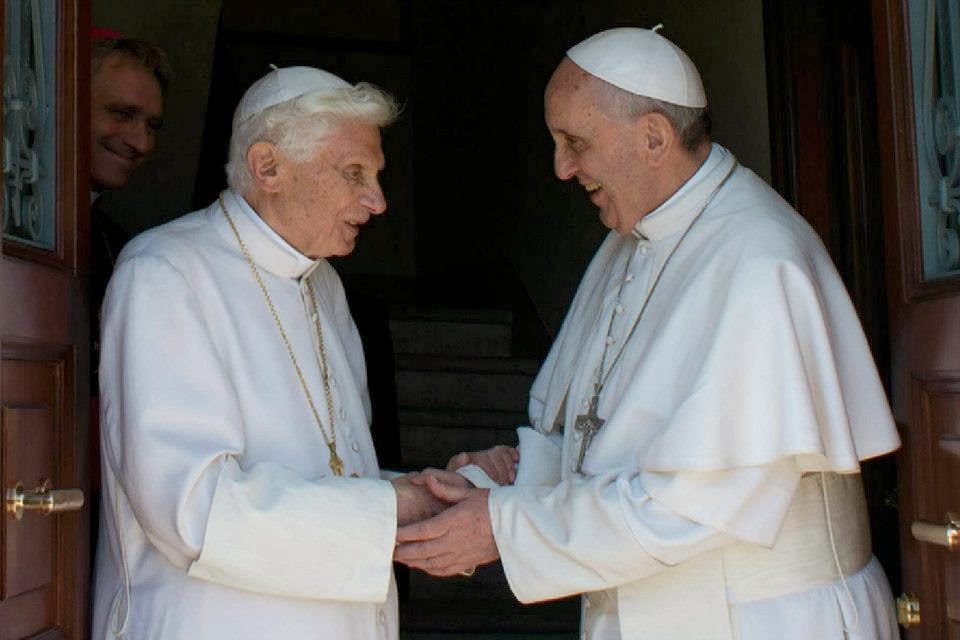
Antonio Socci, who has at various times asserted his own theories on the status and legitimacy of the Francis pontificate (none of which I endorse) has, understandably, a particular interest in stories relating to this topic.
Which is, perhaps, why he took notice of a statement from Archbishop Gänswein — Prefect of the Papal Household and private secretary to Pope Emeritus Benedict XVI — about the relationship between Benedict and Francis. His post is long (and only in Italian) and touches on some of his previous theories about the fullness and legitimacy of Benedict’s resignation. But it is the particular (and very odd) statement from Gänswein that caught my attention above all else. It is taken from a larger speech, given on May 20, in which Gänswein reflected on the pontificate of Benedict XVI (our translation):
From the election of his successor, Pope Francis—on 13 March 2013—there are not then two Popes, but de facto an enlarged ministry with an active and a contemplative member. For this reason, Benedict has not renounced either his name or his white cassock. For this reason, the correct title with which we must refer to him is still “Holiness.” Furthermore, he has not retired to an isolated monastery, but [has retired] within the Vatican, as if he had simply stepped aside to make space for his Successor, and for a new stage in the history of the Papacy, which he, with that step, has enriched with the centrality of payer and of compassion placed in the Vatican Gardens.
Edward Pentin, reporting on the same story for the National Catholic Register, also adds this:
Archbishop Gänswein repeated that Benedict’s resignation was “quite different” to that of Pope Celestine V.
“So it is not surprising,” he said, “that some have seen it as revolutionary, or otherwise as entirely consistent with the gospel, while still others see in this way a secularized papacy as never before, and thus more collegial and functional, or even simply more humane and less sacred. And still others are of the opinion that Benedict XVI, with this step, has almost — speaking in theological and historical-critical terms — demythologized the papacy.”
If you take the time to ponder these statements, they’re really quite staggering. What could it possibly mean for there to be “not then two Popes, but de facto an enlarged ministry with an active and a contemplative member”? How is this a “new stage in the history of the Papacy”?
This seems a momentous statement…and one that calls into question the very nature of the papacy.
Another thing that caught my attention was when Gänswein said “For this reason, Benedict has not renounced either his name or his white cassock. For this reason, the correct title with which we must refer to him is still ‘Holiness.'”
You may recall that in 2014, La Stampa’s Vatican Insider blog reported on Benedict’s response, by letter, to questions they posed about his resignation. Among his statements was this:
“I continue to wear the white cassock and kept the name Benedict for purely practical reasons. At the moment of my resignation there were no other clothes available. In any case, I wear the white cassock in a visibly different way to how the Pope wears it.”
In that same letter, Pope Benedict stated emphatically:
“There is absolutely no doubt regarding the validity of my resignation from the Petrine ministry,” Ratzinger wrote in his letter of reply. The only condition for the validity of my resignation is the complete freedom of my decision. Speculations regarding its validity are simply absurd.”
I do not claim, at this time, to have a workable theory that would resolve these apparent contradictions.
Neither can I seem to quite wrap my mind around these peculiar observations of Archbishop Gänswein, who has the unprecedented distinction of working closely with two living popes. Nonetheless, I find them quite noteworthy, and, most likely, historic. When future generations of Catholics look back on this absolutely unique moment in the Church’s two-thousand year history, they will no doubt do so with an attention to what answers were gleaned from precisely these questions.


